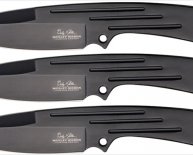
Medieval Swords
A sword is a bladed weapon, consisting in its most fundamental design of a blade and a handle. The blade is usually of some metal ground to at least one sharp edge and often has a pointed tip for thrusting. The handle, called the hilt, can be made of many materials, but the material most common is wood covered by leather, fish skin or metal wiring. The parts of a sword are remarkably consistent between cultures. The basic intent and physics of swordsmanship is fairly constant. This kind of weapon has been in use from the Bronze Age when the construction of long metal blades was possible for the first time. Early swords were made of solid bronze or copper; these were hard, but quite brittle. Not until iron could be forged did the sword truly become an important weapon. Soon, smiths learned that with a proper amount of coal (specifically the carbon in coal) in the iron, another metal (alloy really) could be produced: steel.
Several different ways of swordmaking existed in ancient times. One of the most reputed is pattern welding. Over time new methods were developed all over the world. In Pre-Columbian South America and Mesoamerica several cultures made use of types of swords without developing metallurgy; for example swords with obsidian "teeth" mounted along the "edges" of a wooden "blade".
Having seen use for about five millennia, swords began to lose their military uses in the late 18th century because of increasing availability and reliability of gunpowder weapons. Swords were still used although increasingly limited to officers and ceremonial uniforms. Cavalry sabre charges still occurred as late as World War II during which Japanese and Pacific Islanders also occasionally used swords.
Parts of the sword

- Blade - the cutting part of a sword is the blade. In single-edged swords, the non-cutting edit is the back. The blade may also have grooves or fullers. The purpose of these fullers is not to act as gutters for blood (as was once thought), but to lighten the blade while allowing it to retain its strength.
- Hilt - the handle of a sword, and consists of the guard, the grip, and the pommel. It may also have a tassel or sword knot.
- Scabbard - the scabbard is the case that the sword is kept in when not in use.
- Ricasso - the short section of blade between the base of the guard and the grip. The ricasso is not sharpened, which allows a finger to be wrapped around the guard for better control. On some large weapons, such as the German Zweihander, the ricasso was covered with leather and might be gripped in one hand to make the weapon more wieldy in close quarters combat.
- Shoulder - the short section of blade between the hilt and the start of the sharpened portion of the blade. The maker's mark is normally to be found on the shoulder.
- Tang - the part of the blade extending from the top of the blade through the hilt and the grip. The sword is often held together by a nut screwed onto the tang above the pommel.
- The CoP (Center of Percussion), AKA Sweet Spot - the part of the blade that can deliver the strongest blow with the least vibration.
There are hundreds of types of swords. Here are the most famous:
- Rapier - a longer european dueling sword, optimized more for thrusting than a slashing action
- Small-sword - a very short and light descendant of the rapier.
- Long-sword - a straight, pointed, two edged European sword with a grip long enough for use with two hands.
- Katana and Tachi - Japanese samurai swords (see also Wakizashi)
- Claymore - either of two types of Scottish sword
- Sabre - (saber) a sword with curved edge intended for slashing or chopping
- Jian - a Chinese double-edged thin sword that is straight
- Dao - a Chinese single-edged curved sword, sometimes translated as sabre or broadsword in English.
- Gladius - a Roman legionaire's short swordSeveral modern sports and martial arts have components based upon older principles of swordfighting. Among these are fencing, kendo, kenjutsu, escrima, aikido and some variants of kung fu.
Many swords in mythology, literature and history are named by their wielders or by the person who makes them. - Kusanagi (Grasscutter) - The Japanese equivalent to Excalibur
- Sword of Damocles
- El Cid - Tizona
- The Polish kings - Szczerbiec
- Unferth, associate of Beowulf - Hrunting
- Sigurd - Gram (in the Volsung Saga) or Balmung (sometimes in later traditions)
- Tyrfing - a cursed sword from the Elder Edda
- Durandal - the sword belongs to Roland, a hero of the medieval French epic "The Song of Roland"
- Joyeuse - the sword of Charlemagne (Charles the Great), medieval king of Franks
- Grus- the historical sword of Boleslaw Krzywousty (Boleslaus the Wrymouthed), medieval prince of Poland


















